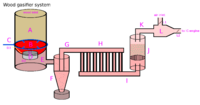
This article deals around the use of wood gas in internal combustion engines.
Overview
schematic of complete system (production unit, fuel generator + ICE-engine) see http://woodgas.nl/GB/project.html , http://www.whatiamupto.com/gasification/woodgastruck.html
Questions --> is a complete system more efficient than separate units ? From the text at http://www.gekgasifier.com/forums/showthread.php?t=22, and given the fact that wood gas has a low energetic value on itself, it seems so, but why ?
- Possibly because thermal heat generated for fuel generator (=the gasifier) is reused in the IC-engine (heated gas expands more) ?
- and/or because the storage of the wood gas is either not possible or requires high pressure and/or heating or cooling
- in what way is wood gas different from smoke ?
Woodgas generator types
- The fixed bed gasifier; for small applications such as camp-site burners.
- The fluidized bed gasifier; for electricity power plants.
- The updraft and crossdraft gasifier; for central heating systems (used to gasify charcoal or coals)
- The downdraft gasifier; for IC engines (used to gasify wood). This type is the only type used with IC engines given that it produces little tar.[1][2]
Wood gas production
The process of biomass gasification is distinctly different form that of biogas production. Gasification is the process by which solid biomass materials are broken down using heat to produce a combustible gas, commonly known as producer gas (or wood gas). Common feedstocks for combustion include wood, charcoal, rice husks and coconut shells.
The biomass gasification plant consists of a reactor, similar to a simple stove, into which the solid biomass fuel is fed. The supply of air to the fuel is, however, carefully controlled to allow only partial combustion of the fuel to take place. During this process gases are given off which are captured and can be used as a fuel gas. Several combustible gases are given off - hydrogen, carbon monoxide and methane - as well as carbon dioxide and nitrogen.
Two reactor types exist; the fluidised bed reactor, which is used with large-scale gasification system, and the fixed bed reactor, which is employed for small-scale producer gas systems. There are three varieties of fixed bed reactor; updraft, downdraft and crossdraft. Each reactor type produces a different ratio of gases at different temperatures and with a differing level of cleanliness.
The gas has several applications. It can be used directly in a burner to provide process heat or it can be used in internal combustion engines, but requires cleaning and cooling for this application. Plant ratings for small-scale power output can range from several kilowatts up to several hundred kilowatts and for heat production the output can be several megawatts. System efficiencies vary considerably depending on fuel, reactor type and application. Producer gas is commonly used for commercial cooking applications.
The small-scale gasifier technology is reasonably simple and cheap and can be manufactured locally, although care should be taken to ensure safety standards are maintained as carbon monoxide, which is produced during combustion, is a toxic gas. In China, a downdraft reactor design has been in production since the 1960's which uses rice husks as feedstock and hundreds of these systems are in use. They have also been installed in Mali, Surinam and India (Stassen 1995). During the Second World War, when fuel supplies were in short supply, millions of vehicles in Europe were adapted to run on producer gas, and today in countries such as Brazil and the Philippines gasifiers are commercially available for a variety of applications.
Schematics
For schematics, see
- http://woodgas.nl/GB/woodgasification.html (Main Imbert dawndraft generator setup)
- http://www.allpowerlabs.org/gasification/resources/papers/Handbook.Reed.Das.pdf (Imbert gas generator schematic, page 93)
- http://wiki.gekgasifier.com/w/page/29160712/GEK-v4_0-CAD-drawings-for-all-sheet-metal-parts
- http://wiki.gekgasifier.com/w/page/6123754/How-to-Build-and-Run-the-GEK-Gasifier
- http://wiki.gekgasifier.com/w/page/6123797/Practical-Engineering
Storage
http://www.gekgasifier.com/forums/showthread.php?t=22
Use
Transport --> not suitable see Comparison of engines Home generation (combined heat and power) --> by means of a regular internal combustion (car) engine, or a lawnmower engine Note: could possibly be combined with a stirling engine, see Comparison_of_engines#The_appropriate_use_of_the_different_engines